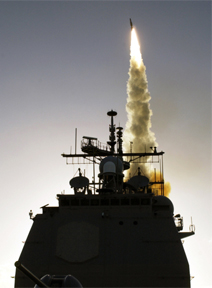
Sandia’s Red Storm supercomputer helped the US Navy figure out how to shoot down an errant satellite in February.
The satellite failed shortly after its launch in 2006 and by early this year its orbit was deteriorating to the point where it was about to reenter the Earth’s atmosphere. The satellite posed a potential safety hazard due to the frozen hydrazine propellant on board. The Navy shot down the satellite Feb. 20, 2008. The work had been classified until last week.
For about two months preceding the event, the Sandia team ran Red Storm simulations to assess and plan the complex mission. Researchers used all of Red Storm’s 26,569 processors to perform simulations that allowed the team to predict various details and possibilities. The information contributed to the decision to proceed, and helped DoD plan and execute the shot, as well as conduct analysis after the satellite was brought down.
The work helped planners decide at what altitude to hit the satellite, how to hit it to minimize the spread of debris, including its hazardous fuel, and the best way to make sure the satellite was destroyed with a single shot.
Bill Guyton, director of Center 5400, says the team was called upon because of its years of experience in missile defense intercept simulations of reentry vehicles.
Daniel Kelly, manager of Lethality and Threat Dept. 5417, led the team of six staff members who were called upon to perform hundreds of impact simulations in a matter of days and weeks to answer critical technical questions affecting early decisions to go forward with the operation.
“We were contacted on Jan. 11, 2008, by the Missile Defense Agency and asked to deliver in nine days the required ‘hit point’ for high probability of success,” says Daniel. “The team put in a lot of long days, and with help from resources across the laboratory, provided results for several pivotal deadlines during the buildup to the operation.”
The team also supported operation day at Schriever AFB, Colo., to assist in the real-time assessment of the event where decisions were made that a second intercept shot was not required.
“Our team did a great job in providing the simulation data necessary to complete this important mission,” said NNSA Administrator Thomas D’Agostino. “This is a great example of the ways that the nation’s investment in nuclear deterrence can be more broadly employed for national security.”